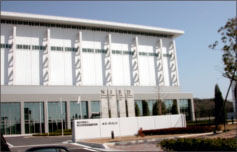NEES/E-Defense Collaborative Earthquake Research Program
8th Planning Meeting
The NEES/E-Defense Joint Technical Coordinating Committee is pleased to announce the 8th NEES/E-Defense Collaborative Earthquake Research Program Planning Meeting. This meeting will be held in Japan on Friday and Saturday, September 17 and 18, 2010. Members of the Joint Technical Coordinating Committee (JTCC) include Julio Ramirez, Farzad Naeim and Steve Mahin.
During the first Japan-U.S. Workshop on Science and Technology for a Secure and Safe Society (held in February 2004), the Japan Ministry of Education, Culture, Sports, Science and Technology (MEXT) and the US National Science Foundation (NSF) agreed to discuss opportunities for cooperative activities related to earthquake research, citing NEES/E- Defense collaboration as a specific example of such cooperation. To realize the cooperation, the First Planning Meeting for NEES/E-Defense Collaboration was held in 2004, and the basic scheme for a five-year joint research was established. To formalize the collaboration, two Memorandums of Understanding (MOU) were executed, one between NSF and MEXT in September 2005 and between NEES Consortium Inc. (NEES Inc.) and the National Research Institute for Earth Science and Disaster Prevention (NIED) of Japan in July 2005. These MOUs cover collaborative activities through 2010.
 A small planning meeting was held in January 2009 to discuss the need for and benefits of a second phase of NEES/E-Defense collaboration. The participants unanimously recommended a second phase be carried out, and recommended a number of high priority research needs to be discussed in future planning meetings. The September 2010 will be the third planning meeting for Phase 2 of the NEES/E-Defense Collaborative Earthquake Research Program. It will follow up on the six project areas proposed from the earlier meetings, namely:
A small planning meeting was held in January 2009 to discuss the need for and benefits of a second phase of NEES/E-Defense collaboration. The participants unanimously recommended a second phase be carried out, and recommended a number of high priority research needs to be discussed in future planning meetings. The September 2010 will be the third planning meeting for Phase 2 of the NEES/E-Defense Collaborative Earthquake Research Program. It will follow up on the six project areas proposed from the earlier meetings, namely:
- New materials and new technologies
- Base-isolation and vibration control
- Geotechnical engineering
- Energy facilities
- Computational simulation
- Monitoring

